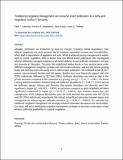| dc.description.abstract | Globally, pollinators are threatened by land-use changes, including habitat degradation. East African rangelands are under pressure due to livestock population increase and overutilization, which lead to degradation of vegetation and soils. While traditional grazing management is widely used to restore vegetation, little is known how this affects insect pollinators. We investigated whether differently managed rangeland areas harbor different insect pollinator abundance, richness and diversity in Simanjiro, Tanzania. We established twelve blocks in four grazing areas under different management categories (private and communal enclosures, wet and dry season grazing lands) and used pan traps and sweep nets to collect insect pollinators. We collected a total of 1977 insects, representing 44 families and 239 species. Beetles were most frequently trapped, with 646 (33%) individuals, followed by 522 bees (26%). Pollinator abundance was twice as high in the private enclosure compared to the communal dry grazing area (χ2 = 27.63, P < 0.001). We found a strong positive correlation between floral and pollinator abundances (r = 0.68, P = 0.015) but not for pollinator species richness and diversity. Bee species abundance and diversity were also significantly higher (χ2 = 68.00, P < 0.0001) in enclosures compared to open rangelands and were significantly influenced by season (χ2 = 220.73, P < 0.0001). Apis mellifera (honey bee) and Lasioglossum of the subgenus Ipomalictus were the most abundant bee species with 107 (21%) and 105 (20%) individuals, respectively. We noticed a significant interaction between season and management on influencing bee pollinator numbers (χ2 = 19.84, P = 0.0002). We conclude that traditional rangeland management can strongly influence pollinator abundance and communities. Our study will aid in developing rangeland management strategies to promote conservation of and enhance pollinator availability in tropical rangelands. | en_US |

